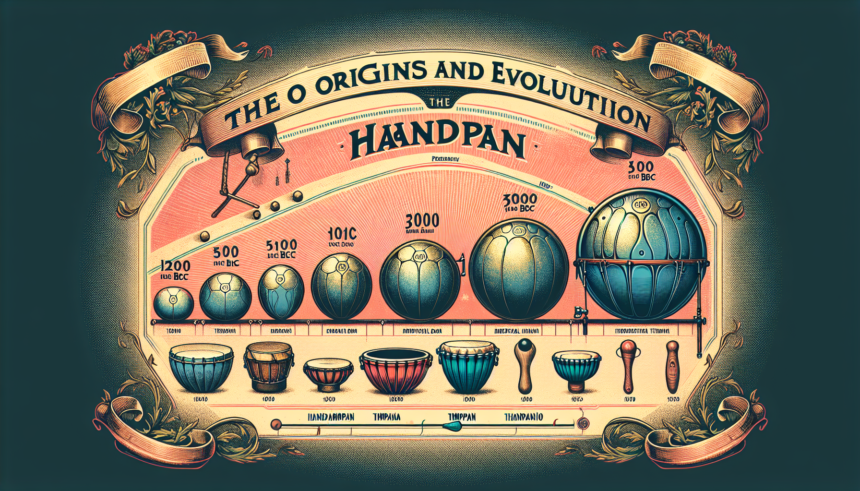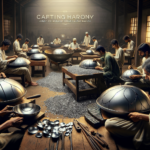Introduction
The handpan is a captivating and unique musical instrument known for its ethereal sound and striking design. Over the past few decades, it has gained a dedicated following among musicians, therapists, and enthusiasts. This article delves into the history, development, and cultural significance of the handpan, exploring how it has evolved from its inception to its current status as a beloved instrument worldwide.
The Origins of the Handpan
The handpan’s history is relatively recent, especially when compared to other traditional instruments. The story begins in the late 20th century with the creation of the “Hang,” an instrument invented by Swiss musicians Felix Rohner and Sabina Schärer, founders of PANArt. The Hang, which means “hand” in Bernese German, was first introduced in 2001 and is considered the prototype of modern handpans.
Rohner and Schärer were inspired by various percussion instruments from around the world, such as the Trinidadian steelpan, the Indian ghatam, and the Indonesian gamelan. They sought to combine elements of these instruments to create a new, versatile musical tool that focused on harmonic resonance and melodic possibilities.
The Development of the Hang
The creation of the Hang involved extensive research and experimentation. Rohner and Schärer developed a unique, convex-shaped steel instrument with a central note (called the “ding”) and a series of tone fields arranged around it. These tone fields were carefully tuned to create a harmonious scale, enabling musicians to play both melodies and rhythms.
PANArt’s dedication to quality and their desire to maintain the Hang’s uniqueness led them to adopt a controlled distribution process. They sold the instruments directly to buyers, often requiring potential owners to visit their workshop in Switzerland. This approach not only ensured each Hang met their high standards but also fostered a personal connection between the creators and the musicians.
The Evolution of the Handpan
As the Hang gained popularity, demand quickly outpaced PANArt’s production capacity. Recognizing the potential of this new instrument, other craftsmen and companies around the world began creating their own versions of the handpan. These instruments, while inspired by the Hang, often featured different shapes, materials, and tuning methods.
The term “handpan” was coined to describe these new instruments, distinguishing them from the original Hang. Handpans typically share the same basic design principles: a convex steel shell with carefully tuned tone fields arranged around a central note. However, each maker brings their own innovations and artistic touches, resulting in a diverse array of handpans available today.
Technological Advancements and Craftsmanship
The evolution of the handpan has been marked by significant advancements in both technology and craftsmanship. Instrument makers have experimented with different types of steel, including stainless steel, nitrided steel, and even titanium, each offering unique acoustic properties and durability.
In addition to material innovations, handpan makers have also developed new techniques for tuning and shaping the tone fields. Some use traditional hammering methods, while others employ modern tools like CNC machines and computer-aided design (CAD) software to achieve precise and consistent results.
These technological advancements have allowed for a greater degree of customization, enabling musicians to choose handpans with specific scales, tunings, and even aesthetic designs. The result is a thriving community of handpan makers and players who continue to push the boundaries of what this instrument can achieve.
Cultural Impact and Global Community
The handpan has made a significant impact on music and culture, inspiring artists across a wide range of genres and traditions. Its soothing, meditative sound has made it a popular choice for relaxation, yoga, and therapeutic practices. Handpan music is often used to create serene and introspective atmospheres, making it a favorite for solo performances as well as collaborative projects.
The instrument’s accessibility and portability have also contributed to its widespread appeal. Handpans can be played by musicians of all skill levels, from beginners to professionals. This inclusivity has fostered a global community of handpan enthusiasts who share their music, insights, and experiences through social media, forums, and gatherings.
Events such as handpan festivals and workshops have become increasingly common, providing opportunities for players and makers to connect, learn, and celebrate the instrument. These gatherings often feature performances, masterclasses, and demonstrations, further enriching the handpan culture and promoting its growth.
Conclusion
The handpan is a testament to the power of innovation and creativity in the world of musical instruments. From its origins in the hands of Felix Rohner and Sabina Schärer to the diverse array of handpans available today, the instrument has evolved and gained recognition for its unique sound and versatility. Its impact on music, culture, and therapeutic practices continues to grow, fueled by a passionate global community of makers and players. As the handpan’s journey unfolds, it remains a symbol of harmony, connection, and the enduring spirit of musical exploration.
FAQs
- 1. What is the difference between a Hang and a handpan?
- The Hang is the original handpan-like instrument created by PANArt, while the term “handpan” refers to the broader category of similar instruments made by various makers worldwide. Though they share common design principles, handpans often have different materials, shapes, and tuning methods compared to the Hang.
- 2. How is a handpan played?
- A handpan is typically played with the hands and fingers, striking the tone fields to produce melodic and rhythmic sounds. Players use different techniques such as tapping, slapping, and gliding to create a wide range of textures and dynamics.
- 3. Can anyone learn to play the handpan?
- Yes, the handpan is accessible to musicians of all skill levels. Its intuitive layout and pleasant sound make it easy for beginners to start playing simple melodies and rhythms, while advanced players can explore more complex techniques and compositions.
- 4. How do I choose the right handpan?
- Choosing the right handpan involves considering factors like scale, tuning, material, and craftsmanship. Listening to recordings, trying out different handpans in person, and seeking advice from experienced players or makers can help you find an instrument that suits your musical preferences and playing style.
- 5. How should I care for my handpan?
- Caring for a handpan involves regular cleaning to prevent rust and maintaining its tuning. Use a soft cloth to wipe the surface after playing and store the instrument in a dry, protective case. It’s also important to avoid exposing the handpan to extreme temperatures or humidity, which can impact its sound and durability.





